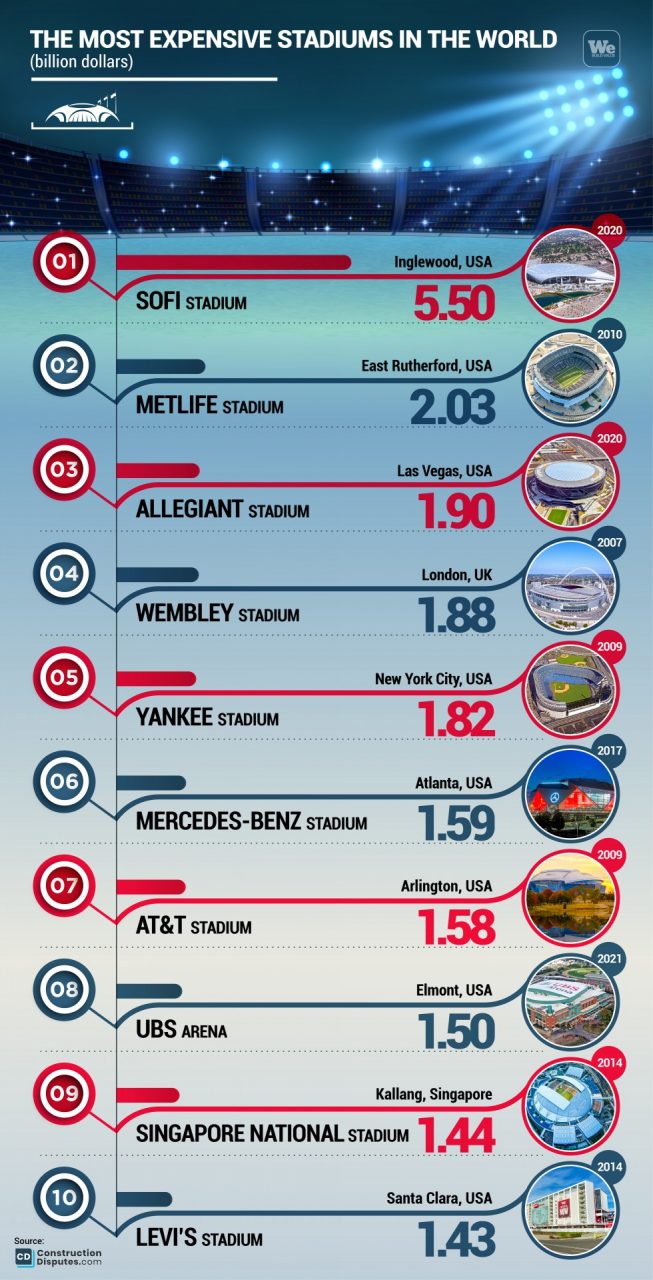Modern, sustainable, welcoming. Places to meet and socialise, and to share an all-consuming passion. But above all, some of the world’s most complex and popular infrastructures.
In recent years, stadiums are becoming the new frontier of civil construction, where the impressiveness of the structure coexists with the imperative of sustainability.
The latest step forward came in recent days when the Los Angeles Clippers, the historic U.S. basketball team, broke ground on a new stadium in Los Angeles. The team will leave the Staples Center, which they now share with the Los Angeles Lakers, and move to their new home at the Intuit Dome, an ultra-modern arena — according to the official announcement – which will be ready to host games for the 2024-2025 season.
The first stadium that will clean up the environment
The Intuit Dome in Los Angeles will rank in third place among the world’s most expensive stadiums. The 18,000-seat arena will require an investment of up to a reported $2 billion (€1.7 billion). The result of four years of work will be not only one of the most beautiful and accessible venues in the world, but an extremely sustainable infrastructure, destined to become the first “climate positive” stadium in the United States. The Intuit Dome it will be able to actually improve air quality, rather than worsen it.
To achieve this goal, Intuit Dome said it has planned to accompany the structural innovations with a new management model for the facility once it opens. First of all, the stadium is being built to obtain LEED-Platinum Certification, the highest certification for green buildings. The arena will be 100% carbon free from day one; it will be equipped with natural ventilation inside; it will be powered by solar panels; and the facility will be equipped with a green waste management system. Moreover, the “Planet Protection Fund” that will offer fans the opportunity to offset their carbon emmissions by using electronic tickets only.
An arena as a new city center
Sustainability and modernity go hand in hand with well-being and quality of life. The new green standards adopted during the construction large American stadiums are designed to offer the public a show, but also and above all, an unmatchable experience.
In terms of experience, spectators at the Intuit Dome will be able to enjoy “Courtside Cabanas,” a private room that on one side will overlook the playing field through a large window, and on the other will have an open space where guests can entertain friends during the breaks in the match. “Backstage Bungalows” will be real bungalows where fans can spend time before the start of the game, or during the interval.
Turning the stadium into a focal point for people ensures that the infrastructure has a truly significant impact. According to statistics provided by the Clippers, its opening will generate a turnover of $260 million in the Inglewood area each year, creating 7,000 full- and part-time jobs.
Clippers Chairman and owner Steve Ballmer, formerly Microsoft CEO, is enthusiastic about the project.
“I’m optimistic about our team. I’m optimistic about our team success, and that optimism is a force multiplier. In many ways, the reason we did this is consistent with that optimism as a force multiplier approach,” he said during the groundbreaking announcement in September.
The world's most expensive venues
The Intuit Dome in Los Angeles is one of the costliest arenas in the world, near the top of a list that shows just how central these infrastructures are, and their strategic role in new models of urban development, based on sustainability and the well-being of people.

Currently, the record for the most expensive stadium in the world remains in California, where SoFi Stadium in Inglewood was inaugurated after years of work and an investment of $5.5 billion (€4.7 billion).
This structure, like the Allegiant Stadium (the world’s third-most expensive, also opened in 2020), is unique: 70,000 seats with larger and more comfortable seats, private suites to watch the game, and huge screens to follow the action.
This is the most expensive stadium ever built, the home of the Los Angeles Chargers and Los Angeles Rams, over twice as expensive as Metlife Stadium in New Jersey, which occupies the second position in this ranking. Billion-dollar investments that are concentrated mainly in the United States where 22 of the 30 most expensive stadiums in the world are located. Five of them in the New York City area – once again demonstrating that the Big Apple is the capital when it comes to new trends that change the world.

